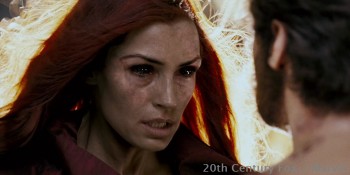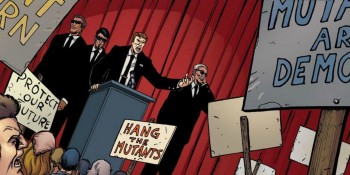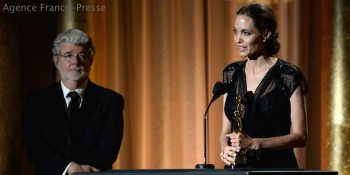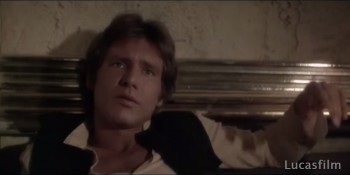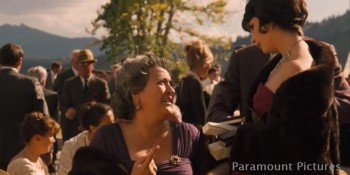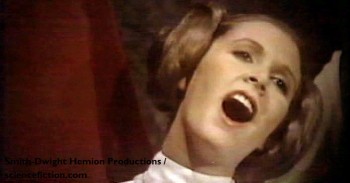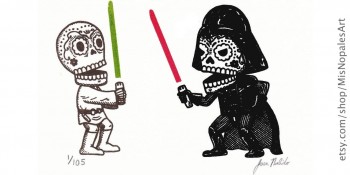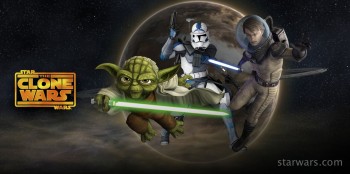It has always surprised me that fans of the X-Men films really don’t like the third installment, X-Men: The Last Stand. Admitting that you like X-Men 3 is enough to get you sidelong looks from your fellow nerds at best and scathing criticism about your nerd-cred and taste in films at worst. Say that you enjoyed The Last Stand in the company of your fellow comic-book fans at your own risk.
But with X-Men: Days of Future Past making its way to theaters, I felt it was time to revisit the third film in the franchise and talk about what it does right and why I like it. And I don’t mean that I like it in comparison to, say, X-Men Origins: Wolverine, a film that deserves the vitriol heaped upon it by fans (a proper destruction of which warrants an article in itself). I think The Last Stand deserves its place among the X-film pantheon and is, in fact, the perfect film to set up the translation of the iconic “Days of Future Past” storyline from page to screen.
There are legitimate criticisms leveled at The Last Stand. I really don’t think Halle Berry is a strong enough actress to pull off her role as Storm, successor to the leadership of the X-Men. James Marsden’s Cyclops and Ben Foster’s Angel were both chronically underused. This is particularly regrettable with regards to Angel, a character that could have given us some serious insight into the world created by this film.
I really think the producers of X3 dropped the ball on Vinnie Jones’ portrayal of the Juggernaut. There were any number of other, just as recognizable, bruisers in the pages of the X-Men comics that would have been easier to translate to the screen. The Juggernaut has a complex relationship with Professor X and, to boot, isn’t even really a mutant; his powers derive instead from the Crimson Gem of Cyttorak. While I like the character in the comics, I don’t think he has a place in the film universe.
The same can be said (and has been by my colleague Charissa) of the incredibly abbreviated version of the Phoenix sagas that begins in X2 and concludes in X3. There is no space travel, no Shi’ar, really none of the defining aspects of that storyline outside of Jean Grey’s incredible psychic powers. But that really doesn’t bother me as much.
That might come as a surprise to you. After all, one of the marks of the true nerd is the desire to be technically correct, because it is the best kind of correct. But if you enjoyed the Lord of the Rings films despite the innumerable differences between the book
and the movies, then you really don’t have a leg to stand on with this complaint. Film and comics are different mediums with different rules.
It would take a lot of time and effort to do an accurate adaptation of the original and Dark Phoenix sagas, and I don’t blame the writers and the director for opting to take a shorter route, less grounded in comic book lore. The Phoenix sagas are cosmic stories, and the X-Men movies have been about human stories: a group of people who are born different, trying to make their way in a world that doesn’t want to treat them as human. X3 director Brett Ratner made the right choice here, and because of that choice, the movie remains thematically consistent with the other entries in the franchise.
Perhaps Dark Phoenix should have been left out of the third film altogether, but I don’t want to dwell on what The Last Stand does wrong. Let’s look instead at what it does right.
First, this movie sets up and connects the sundry X-Men films. Putting aside the atrocious Origins: Wolverine film, the X-Men film series has had two acts so far, and with the release of Days of Future Past, we will be moving on to a third. X3 acts as the bridge from the prequels, through the original trilogy, and into the next era. It introduces elements of the Future Past saga: Trask and the Sentinels show up here, and the plot includes several references to the massive power of mutants, which makes a good connection to the newest film. X3 also segues directly into the rather enjoyable The Wolverine, which is a really fine film that primes Wolverine’s character development for Days of Future Past.
The relationship between Professor X and Magneto is handled wonderfully in The Last Stand, and the groundwork is laid for the first-act prequel X-Men: First Class. While that film would explore the beginnings of the friendship between the two mutant leaders, X3 explores the endings, showing a troubled Professor X who has to live with the consequences of his choices and a Magneto who is finally depicted on screen as the mesmerizing and influential leader of a violent revolution.
This character exploration leads directly to another thing X3 does very well. The actors, on the whole, absolutely nail their characters. I love Kelsey Grammar as Beast (complete with an “Oh, my stars and garters!” line). I think Hugh Jackman is dead-on with his Wolverine. I love the conflicted Professor X and the charismatic and driven Magneto. I love the near endless little shout-outs to the X-Men universe in the form of the extended cast of mutants. And the way Bobby Drake finally lays the smackdown on Pyro is just epic.
The action sequences are top-notch. The fight in Jean Grey’s house, the subtle and effective depiction of Magneto’s convoy takedown, the incredibly rewarding and exciting final conflict — each action sequence is fast and exciting and chockablock full of mutant powers and comic-book references. I particularly enjoyed the Fastball Special (a true X-Men classic) and the casual yet overwhelming power of Magneto. The characters move in a way the evokes the comic book action sequences, and I get a thrill watching Beast somersault through a battlefield or Bobby Drake do the full Iceman transformation.
I get that The Last Stand is not as cerebral as some people might have liked, and it is definitely aiming more for “big-budget action flick” than for “accurate-as-can-be comic book film,” but it retains elements of that intellectual, questioning nature, and it does something that no other film in the X-Men franchise had yet done: It shows, for the first time, that this is a world where there are mutants who aren’t X-Men or members of the Brotherhood. The film portrays the mutant community in a moment of crisis, and that’s what makes it brilliant.
The first two X-Men films are essentially superhero movies. Sure, the superheroes are born with their powers instead of getting them from gamma radiation or power armor or a super soldier serum, but they still pretty much use those powers to fight the bad guy who wants to do bad things. Those films are either conflicts between the Brotherhood and the X-Men or between a small group of mutants and a shadowy government agency. We never get a sense of the rest of mutant-kind.
With the central conflict of The Last Stand revolving around the so-called “mutant cure,” Ratner had a reason to depict the larger mutant community. Thats what makes X3 special. Whereas the other films are full of mutants who are heroes and villains, many of the mutants in The Last Stand are citizens, or students, or politicians, or community activists. We get to see how the cure impacts the world beyond the scope of super-powered combat and action. We get to see how this community reacts to the presence of a drug that can take their mutation away. They wrestle with the implications and challenges of this new reality.
The X-Men provide us with a way to look at how we treat the “Other” and the outsider, the marginalized and the misrepresented. By allowing us to see the broader scope of the mutant community, by turning them into people and not just heroes and villains, we are forced to reckon with the question of how we would use a drug that would change the Other. And when that X-factor that we seek to change is a source of potentially overwhelming power, we have to ask ourselves if we want to change the Other to make them more like us … or to take their power away so they don’t threaten our way of life.
While The Last Stand is far from a deep and philosophical look at how we treat our fellow man, it does a great job of creating an exciting and immersive film that highlights a crucial aspect of the human condition. If you plan on catching Days of Future Past in theaters this weekend, you may want to reacquaint yourself with this movie. You just might like it better the second time around.
